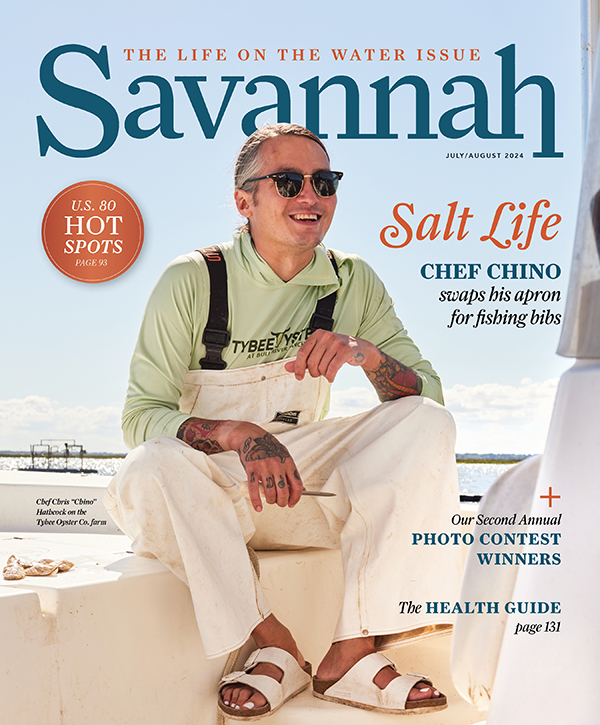On the water with Savannah’s crab king. By Joseph Housley. Photography by Beau Kester
Steve Tootle is sitting at his kitchen table with his three sons, eating breakfast: a pound and a half of bacon, a dozen and a half eggs cooked every which way, sausages, buttered toast, fresh fruit, grits. Plates of food lay scattered before them as they discuss the weather, forecasting the day’s journeys, the way they hope things will go. Through a wall of windows, they peer out at the marsh and the long dock leading to the Vernon River. At the end of the dock an outbuilding rises, filled with traps and gas cans, ropes and boats. They’ll head out soon, going separate directions, each covering different territory. It’s a lot of work, this life. “You’d only do it if you loved it,” Steve says. The Tootles are crabbers.

Steve has caught and sold crabs in Savannah for over 30 years. Although his sons—Stephen, 30, Kyle, 28, and Ben, 19—have followed in his footsteps, Steve doesn’t come from a fishing lineage. “I got into it by accident,” he says, chuckling. When he moved into his house in 1987, Steve was working in the insurance business with his father and brother. He was close friends with his new neighbors, and their son was searching for a summer job. Looking out at the water, Steve suggested the boy buy some crab traps and drop them in the river. To Steve’s surprise the boy followed through on the idea, and soon had traps in place. It was a successful little business for a while, but when the boy’s boat broke down, he made Steve a proposition: If he bought a boat and supplies, the boy would work for him. Steve accepted. For five years the arrangement thrived, until the boy, by then a young man in his twenties, told Steve he was leaving to become a tugboat pilot. So Steve took over, crabbing in the morning and working insurance in the afternoon. A few years later, he left the insurance business altogether to become a full-time commercial crabber.

Today, the crabbing industry in Savannah is mostly composed of a coterie of longtime fishermen, including a few pairs of fathers and sons. The Georgia Department of Natural Resources (DNR) asserts there are 131 commercial crabbing licenses in the state, and only 24 in Chatham County. Of that number, about half are actively in use. Thirty years ago, when Steve was starting out, anyone with 12 dollars could buy a license, he remembers.Georgia’s year-round crabbing business attracted many Northerners, particularly those in states like Maryland, whose season is traditionally limited to around eight months a year.
Soon scores of fishermen were over-harvesting Georgia waterways, shipping the crabs back up north. Recognizing a need to limit the number of commercial crabbers, in 1998 the DNR quit issuing new licenses. For 15 years, any crab license that wasn’t renewed was made available through lottery. In 2013 the process changed again: The lottery was discontinued, and if a license wasn’t renewed it was subtracted from the total number available. “The only way to get a license now,” Steve explains, “is to buy somebody out.”

Steve leaves home as early as he can, heading out on his flat-bottom Carolina Skiff. Depending on the time of year, there’s always something to surmount—the dark, the heat, the wind, the rain, the bugs. In the summer, he leaves hours before daybreak to cope with the oppressive temperatures. His boat stops at each of the nearly 200 red-and-white buoys marked #160, where his systematic procedure is sure-fire and quick: Pull up the trap, dump out the bait, unlatch the trap and pitch the crabs into large wooden boxes. From there, he grades them—large males, medium males, females—throwing back the undersized and the white-bellies, which are less meaty because they haven’t yet grown into their new shells. He places the keepers directly in bushel baskets, then puts new bait in the traps, drops them in the water and motors off to the next buoy where he repeats the same steps. If he’s lucky, a trap might have upwards of 40 crabs in it, but Steve’s still happy with less—a couple dozen per trap is a good haul.

To catch the best blue crabs, Steve traverses the byways of Savannah that most people only glance at while speeding down the parkways and causeways. His route begins in his backyard and sidewinds through the Vernon River to the Skidaway Narrows, down Moon River to the Little Ogeechee and out to Green Island Sound, hooking past Ossabaw Sound to the beachfront of Wassaw Island before returning inland through Odingsell River and Delegal Creek. It’s a six-hour trip on a good day, and his work doesn’t end there.
Once he’s loaded his boat with crabs, Steve returns home to unload the catch into a walk-in cooler behind his house, before stocking up his truck for deliveries. Circling Savannah’s diverse neighborhoods and cultural enclaves, Steve makes drop-offs at markets including Russo Seafood, David’s Crab House and Seafoodlicious. Local purveyors are Steve’s primary consideration—his business fuels their businesses, and some of the relationships go back decades. These daily interactions may be brief, but they reinforce the connection between Savannah’s crabbing brotherhood and its ties to the community.

Many days when he returns from his rounds, Steve is greeted by a truck or two idling in his driveway. They come from Virginia, Maryland and North Carolina, and they’re ready to pack up and go. More markets and restaurants are waiting. Steve leads them to the crabs set aside in his walk-in—always ensuring that orders from his local customers are fulfilled first—and the distributors load bushel upon bushel into their refrigerated trucks before heading back down the road. Steve’s grateful for the overflow. When the northern states can’t crab due to seasonal regulations, they come south and pay top dollar.
Although Savannah’s crabbing community is united in purpose, they are divided by competition. Crabbers are a defensive bunch, protective of their territory and disinclined to mingle. Many are friendly as a professional courtesy—they may wave as they pass each other on the river, or help with a broken-down boat. Yet at their core, each is trying to catch more crabs than the other. Encroach upon a crabber’s water and expect the worst. “They’ll steal your traps, cut your traps, steal your crabs. It can be cutthroat,” Steve says. Whenever a commercial crabbing license is sold and a new crabber sets out, these types of skirmishes often occur—and it can be months, even years, before they’re settled. Clashes are simply a part of the cost of doing business. These are the rules of the river.

Another threat, less predictable but all too real, is the weather. Between 1998 and 2002, drought scourged the crab population and threatened the local industry. Wary of the income fluctuations that accompany a trade dependent on environmental conditions, Steve has maintained his insurance license since the beginning, and returned to selling policies when the going was slow. During this time other crabbers were not so fortunate, filling far fewer traps and eking by, or quitting the trade altogether.

For Steve, returning to insurance was only ever a stopgap. “I love being outdoors—I always have,” he says, his skin darkly tanned from a lifetime in the sun. As evening falls, his youngest son, Ben, walks with him outside to inspect the tables full of peeler crabs, shuffling around in the middle of a molt. Early spring is softshell season, which can last anywhere from three weeks to two months. During this time, Steve must monitor the tables over the course of each day, waiting for the crabs to shed. “You have sleepless nights,” he says. “Once peelers start shedding, it’s 24 hours a day.” When they shed, they become softshells—a delicacy prized for their tender meat. At this point Steve pulls them from the tables and immediately readies them for delivery, where they will appear on the menus of some of Savannah’s best restaurants, including the Olde Pink House and Elizabeth on 37th.
Back at the house, Steve talks about the rivers, the creeks and the cuts of Savannah. He describes the wild pigs on Ossabaw and Wassaw islands, how he’s seen them swimming between channels, only their snouts and ears visible above the waterline. He recounts skies filled with osprey, anhingas, cormorants and bald eagles, with egrets and herons, wood storks and roseate spoonbills. Earlier that day he saw a baby dolphin, maybe 18 inches long, swimming beside his boat as brown pelicans trailed the skiff.
The next day, Steve’s sons will arrive again before dawn and his wife, Paula, will prepare another breakfast for her boys. This is what life as a crabber is about: mornings around the table and days together on the boat. Working side by side, growing up and old together, fishing the rivers, raising children and grandchildren and being a part of the same story. It’s the family business, and Steve has no plans to stop. “Why would I?” he asks, looking around, surrounded by everything and everybody he loves. A black lab and a German short haired pointer race around outside. A great blue heron flies over the dock and settles nearby in the marsh. “When I leave here,” Steve says, half-laughing, “it’s gonna be 10 toes up.”


